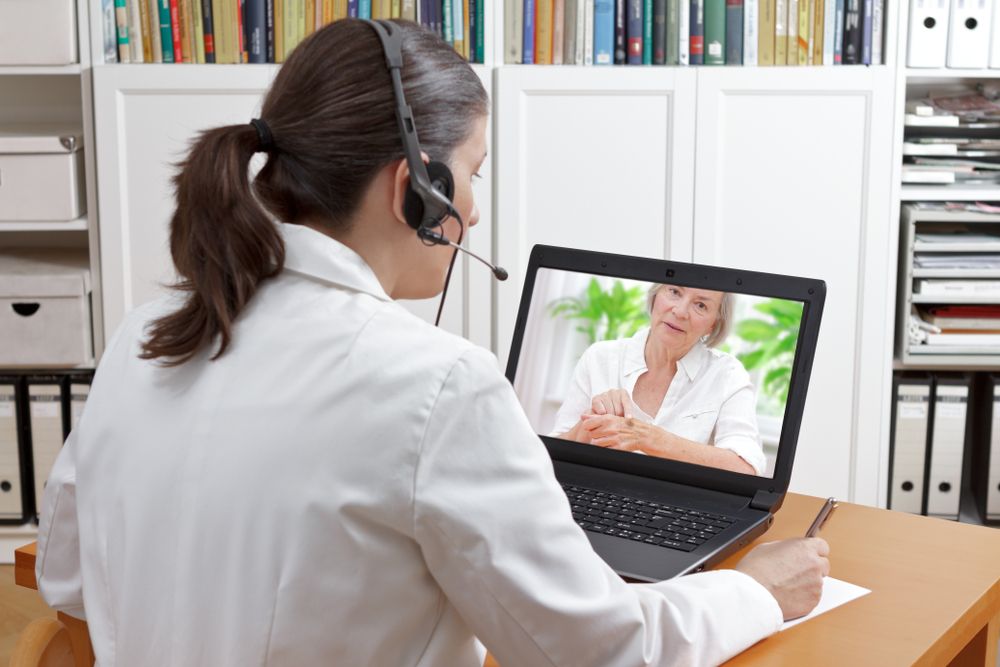According to the American Academy of Dermatology (AAD), teledermatology can:
- Offer clinical support to patients.
- Increase access to care by reducing geographical barriers.
- Use various forms of technology to provide comprehensive care.
- Improve patient care and outcomes.
- Offer cost-effective solutions.
The advance of technology is changing the face of medicine and health care in the United States. Telemedicine allows health care providers to interact with patients from afar and can increase access to care.
Dermatology is a field of medicine that often requires care from a specialist. There are often far more people seeking out a dermatologist than there are specialists to go around. There are fewer than 15,000 dermatologists practicing medicine in the United States, and dermatology is one of the top five specialties sought out for care. This is where teledermatology can help. (Learn More)
Teledermatology can be a great option for providing care to people who suffer from skin conditions but are unable to get in to see a specialist because they live in a remote or underserved area. It can also decrease the number of visits to emergency departments for issues related to the skin. (Learn More)
If you suffer from legions on the scalp or need help with a possible skin cancer diagnosis, an in-person doctor visit is preferred to teledermatology. (Learn More)
Teledermatology is best used in tandem with in-person visits when needed as part of a complete model of care for skin conditions and related medical concerns. (Learn More)
What Is Teledermatology?
Teledermatology is a form of telemedicine that uses both live-interactive (synchronous) and store-and-forward (asynchronous) methods to provide health care. It offers virtual health care and digital connections with doctors and providers who are not in the same location as the person they are treating.
In many ways, the dermatology field is ideal for this type of care, as it often involves looking at pictures and images to diagnose skin conditions. This can often be done virtually, which can save patients a trip to a specialist.
Synchronous teledermatology includes live chats between primary care physicians and dermatologists to diagnose a condition, design a care plan, manage a condition, and provide follow-up care for patients. This real-time interaction uses video technology so doctors can communicate with each other and provide a high quality of care. Patients can also use synchronous teledermatology to talk directly to their dermatologist through a video chat.
The store-and-forward method of teledermatology is often preferred, as it is generally more cost-effective. This method allows patients or their primary care providers to send images, pictures, and medical history to the specialist. Images and files are uploaded through an encrypted format for dermatologists to use to diagnose an issue and form a treatment plan.
Best Uses for Teledermatology
Some of the major pros of teledermatology include:
- Greater convenience.
- Improved access to treatment.
- Reduced cost.
- Fewer emergency visits, decreased wait times for those in critical need, and enhanced scheduling.
Teledermatology can increase access to care. If you live in a rural area, or even just somewhere where there may not be a dermatologist or the exact type of specialist you need to see for your specific condition, teledermatology can be an ideal way to get your questions answered and your condition looked at without driving a far distance.
Store-and-forward teledermatology appointments can get your condition diagnosed accurately and quickly by the right person. You may be able to get a teledermatology consultation much quicker than an in-person appointment as well.
Teledermatology can save time and driving distance as well as money. It is considered to have fewer associated out-of-pocket costs than most in-person services.
If you have a rare condition, you may have to go through various doctors before you are referred to the right specialist. Teledermatology consultations can help to decrease the number of actual appointments you have to attend. This means you can get the right care more quickly without jumping through as many hoops.
Possible Limitations of Teledermatology
When it comes to diagnosing and managing skin conditions, teledermatology can typically be very effective and provide a high quality of care. Digital imaging is very advanced, and technology interfaces allow for many options for virtual care. There are some possible cons to teledermatology, however.
Some skin conditions, including scalp psoriasis, are difficult to diagnose through images alone. It can be hard to get a good picture of your scalp and the legions. It is also tough to discern the depth or breadth of these legions without seeing them in person. Often, a dermatologist will need to look at your head directly to make an accurate diagnosis and treatment plan for managing scalp psoriasis.
High-risk skin cancers, such as squamous cell carcinoma (SCC) and melanoma, cannot be easily diagnosed through teledermatology either. These cancers require an in-person visit with a specialist and a potential biopsy to diagnose.
While many insurance policies, including Medicare, often offer coverage for teledermatology services, there are still several states that do not reimburse for this type of care. This can be a major barrier for teledermatology.
When to Use Teledermatology
Teledermatology is optimally used as part of a complete system of care. This means it can enhance your medical care and treatment, but it is best used as an adjunctive form of care in addition to in-person medical services.
You may use teledermatology services for an initial consultation with a dermatologist, or it can be used as a meeting ground between your primary care provider and the specialist, as a way to coordinate care. You may see your primary care provider first for potential skin conditions and then use teledermatology to obtain a diagnosis or care management plan from a specialist. At this point, the dermatologist may determine that an in-person visit is warranted, or it may be something that can be diagnosed, treated, and managed virtually.
Teledermatology is a great option if you live in a rural or underserved area. Typically, dermatologists are concentrated in urban areas, and there may not be one in your general vicinity. If you need help with a specific skin disease, issue, or condition, teledermatology may be able to provide you with a consultation faster, more conveniently, and often at a lower cost.
While teledermatology can close some gaps in health care and provide more people with more options, it won’t fully replace in-person care.
References
Market Profile of U.S. Dermatologists. (2015). One Key.
Teledermatology Toolkit. (2018). American Academy of Dermatology (AAD).
Teledermatology: An Updated Overview of Clinical Applications and Reimbursement Policies. (May 2017). International Journal of Women’s Dermatology.
Teledermatology: Benefits and Challenges. (August 2018). Dermatology World.
Teledermatology for Diagnosis and Management of Skin Conditions: A Systematic Review of the Evidence. (January 2010). Department of Veterans Affairs.
Pros and Cons of Teledermatology. (June 2017). National Psoriasis Foundation.
Teledermatology for Diagnosing Skin Cancer in Adults. (December 2018). Cochrane Database System Review.
The Legal Landscape of Teledermatology. (February 2017). AJMC Managed Markets Network.
















